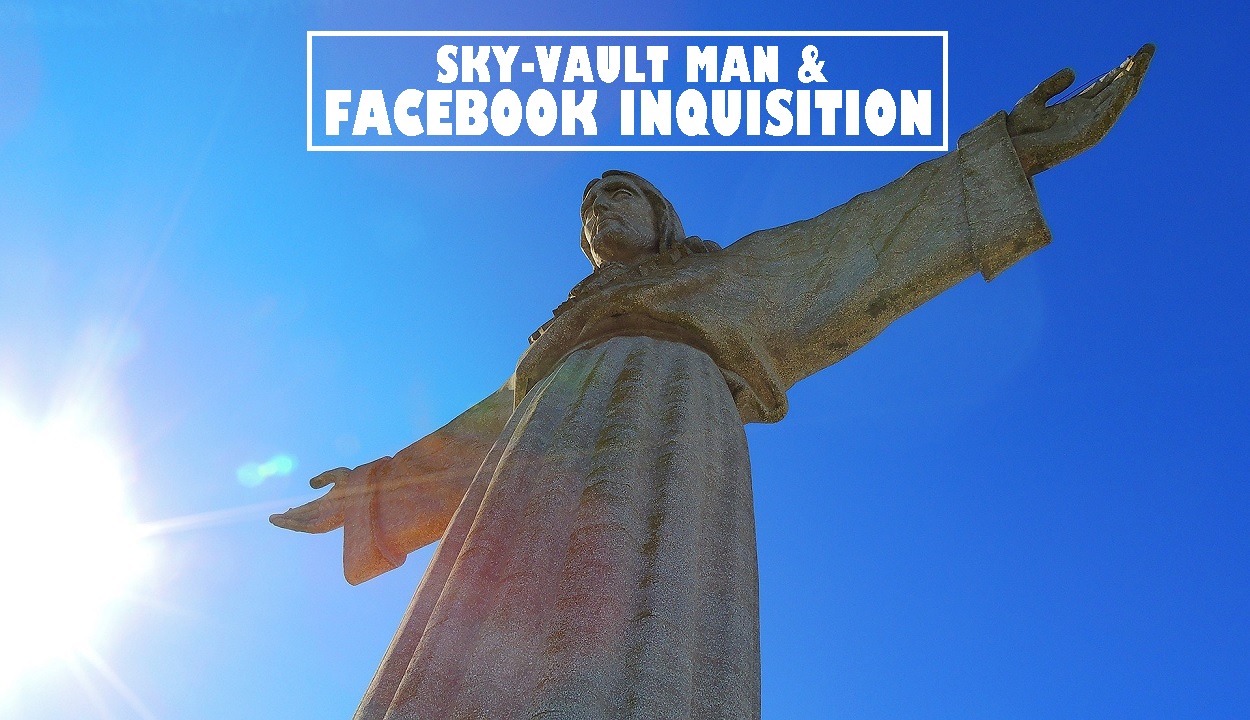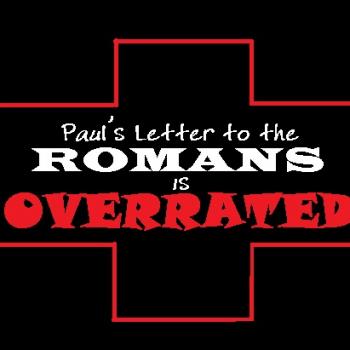
Sky-Vault is just one of many strange expressions that will get you tried for heresy on Facebook.
“Fellow Dying Inmate, what is the Sky-Vault man?”
An administrator of a Facebook group asked me that question some time ago. Apparently, I pissed her off using an unfamiliar term—an unpardonable offense to the Gatekeepers of Verbal Orthodoxy. Such charity in Catholic “Defenders” these days. If you say something unfamiliar, people will conclude that it must be heresy—and you are dangerous.
So, I explained to Roberta Bellarmine that in the Gospel called “John,” the Son of Man (spurious familiar term!) is a sky being, hence a “Sky-Vault Man.”
Why sky-vault? Why not heavenly? Or, for that matter, why not “sky being”?
Here’s a video diving into why—
Why “Sky-Vault Man”? It’s because ancient Mediterraneans, such as first-century Israelites, knew sky lore, not science. They lacked our meteorology, weather science, astronomy, and contemporary cosmological views. More or less, they figured that the earth was a stationary sphere enclosed by a series of crystalline spheres or “sky-vaults.” On the outermost of these “sky-vaults” dwelt the highest God along with a fancy entourage of sky servants.
As to how ancients discovered the proper shape and circumference of the earth, here’s Dr. Carl Sagan—
https://youtu.be/FT_nzxtgXEw?t=1718
Origins of Sky-Vault Man
“I have never heard of any such thing!” retorted my Holy Inquisitor. Why? It’s because her reading never takes her beyond the media she already head-nods to. The book precisely you need to be reading is the one that is above your head, says Mortimer Adler. But my Inquisitor doesn’t figure that. Only what’s approved by the echo chamber is approved reading for Roberta Bellarmine.
We learn about how the “Son of Man” is a “Sky-Vault Man” from works like Daniel 7, 1 Enoch, and the Fourth Gospel called “John.” “John,” says that when the sky-vault opens, God’s angels ascend and descend on the Son of Man like a cosmic ladder (John 1:51). Because in this role, the “Son of Man” stands between sky-vaults above and land below means he is indeed a Sky-Vault Man.
Add to this that he came down from the sky-vault and also returned to the sky-vault (John 3:13). In fact, the Johannine narrative informs readers it’s a fact that he will ascend back up into the sky-vaults (John 6:62).
Synoptic Sky-Vault Man
The Synoptics also refer to the “Son of Man” as a sky-vault entity, hence, a “Sky-Vault Man.” Not all Synoptic passages that use “Son of Man” apply it to Jesus! Some passages do, but others, stemming from very early traditions, mean someone else entirely (e.g., Mark 8:38; Luke 9:26; 12:8). In such passages, this entity is a sky being who will descend with power in glory from the sky-vaults (Mark 13:26; cf. 14:62; Matthew 26:64).
In several Synoptic passages, the Son of Man is a sky being expected to come to deliver ultimate judgment. As in “John,” he is a Sky-Vault Man (Matthew 10:23; 13:41; 16:18, 27; 19:28; 25:31; Luke 18:8).
Israelite Sky Lore
Then consider that the greater Israelite sky lore, something odious to my Inquisitor, may simply be at fault by sounding exotic and strange to her. The book of Revelation refers to the Son of Man / Sky-Vault Man. So does another work, one very influential on Revelation and other New Testament documents—1 Enoch. We can go on and on with that… and I did, with High Inquisitor Roberta Bellarmine.
Neither 1 Enoch or Revelation should be called “apocalyptic” or “eschatological.” Instead, they are astronomic reports or Israelite sky lore and examples of “nextology”—detailing events expected to happen soon, as in very soon, much sooner to their authors than 2021 and after! Revelation 12:1-5 provides the origins of the Sky-Vault Man / Son of Man. Reading 1 Enoch helps us better understand what the author of Revelation communicated.
Apparently, the only celestial “Son of Man” known to Israelite tradition is precisely this Sky-Vault Man, understood as the constellation we name Aries, the Ram. Yes, you read that correctly. But what does this mean? Well, if Jesus is this Son of Man or “Lamb of God” in the Fourth Gospel we call “John,” then that means that in “John” he is the Sky-Vault man who has descended from sky-vault. Since this gives us the context of what “John” meant, shouldn’t we translate “Son of Man” (τoν υἱoν τοῦ ἀνθρώπου) as “Sky-Vault Man”?
Outrageous But True!
“Outrageous!” spat my Inquisitor. Perhaps. But that’s how our ancestors in the faith believed. And then Christology evolved and evolved over centuries. Contexts changed. With such growth, believers lost the older contexts.
The God of Israel sealed this Sky-Vault Man, Jesus (John 6:27). Jesus, the Sky-Vault Man, provides life-sustaining food (John 6:53). How ironic that the Sky-Vault Man Jesus, who ascends and descends at will, gets “lifted up” by mortals on the cross (John 3:14; 8:28; 12:34) and is glorified (John 12:23)! This is how he draws all Israel to himself (John 12:32). By “being lifted up,” the Sky-Vault Man discloses “by what death he was to die” (John 12:33).
Revelation informs readers of the ancient pre-Christian belief that the Sky-Vault man is a cosmic Son born of the Sky Woman (not Mary in Revelation). This work doesn’t state who his father is. Therefore, it must be God (just like in the Lucan genealogy Adam is begotten “of God,” Luke 3:38).
So the Sky Son—the Sky-Vault Man—was once understood to be born of the pregnant Sky Woman (not Mary, and not human) before the foundation of the world. As scholars Bruce Malina and John Pilch indicate, he must be God’s own Son, the Sent One from sky-vault—at least according to some ancient messianists.
Bad Taste For The Sky-Vault Man
That was a lot to swallow. Indeed, it was too much for my Facebook Inquisitor. Scott Hahn never told her any of that! But that’s just it—Hahn is a popular Catholic speaker. Roberta Bellarmine has no way of distinguishing people like Hahn from world-leading exegetes.
Popular Catholic speakers and so-called apologists do a lot of damage, really. They go around thinking that they are Catholic superheroes, informing people and protecting them from heresy. But most of them are really little more than champions for Catholic fundamentalism.
Here’s a lesson none of them teach: official Catholic teaching isn’t competent or interested in defining the literal sense of Scripture. It’s sad to think that many Catholics still don’t realize this.
Literal Sense of the Sky-Vault Man
Please understand that the Magisterium and Tradition of our Church are not really concerned with defining the literal sense of Scripture. Shocked? That’s not really the business of the Magisterium. It hasn’t been doing that really over the past two thousand years either.
Don’t be confused. Modern commentaries produced by exegetes like the Context Group scholars I often cite deal with the literal sense of Scripture. Official Catholic Teaching hasn’t issued official interpretations in that area—exegesis deals with that domain, not so much theology.
Again, the literal sense is the meaning intended by biblical authors and understood by his audience (people living in the author’s time and culture). Ordinarily, biblical scholars and commentators—unlike the Magisterium—are all about finding this literal sense (see CCC n. 116). The Context Group of Biblical Scholars and other such authentic Scripture commentators do not attempt to establish doctrinal positions that would bind readers today.
So, when my Facebook Inquisitor spat, “What Church teaches this nonsense about Sky-Vault Man?” I was happy to inform her that I wasn’t giving doctrine or dogma here. No one is proposing doctrinal positions to interfere with or challenge the Official Teaching Office of the Catholic Church. Instead, scholars produce this material by exegetical findings that help illuminate how earliest Jesus groups believed at the roots of the history of the Body of Christ. The Spirit guides (not coerces) the Body and its Shepherding Authority (Magisterium) as doctrine slowly and arduously unfolds, evolves, and develops through various struggles over millennia.
Limits & Competency of the Magisterium
Has the Catholic Church ever defined the meaning of any Scripture passage in terms of what we might call the literal sense of Scripture? As Raymond Brown explained to his Inquisitors, it is highly doubtful. I know that’s contrary to POPULAR but SPURIOUS understanding, but that’s just the way it is.
As Brown says, the Church has defined that some (not all) of its doctrines are related to scriptural passages. But it does not follow to insist that necessarily those doctrines were in the minds of the people who wrote the passages, and that is the meaning they intended. What this means is that any conflict between the scholarly interpretation of the literal sense and Church doctrine based on Scripture (i.e., the spiritual sense, CCC 117) is really irrelevant here.
Roberta Bellarmine couldn’t, or rather wouldn’t, swallow my “Catholic Answers.”
Wake up time, 21st-century Catholics! Popular apologists and Catholic speakers on EWTN and other fundamentalist outlets are not exegetes. I have in mind Dr. Scott Hahn and a whole lot of other folks, including bloggers here. I know that this will hurt feelings, and I certainly don’t intend to do that, but Hahn and friends are not exegetes. Biblical theologians and popular speakers are not necessarily exegetes. Ultimately, popular spurious (and nonscholarly) opinions won’t work alchemy here.
















